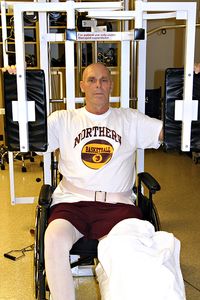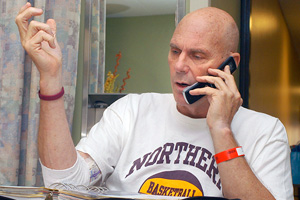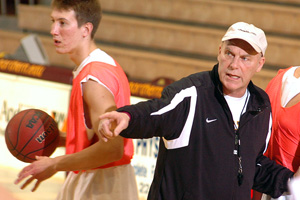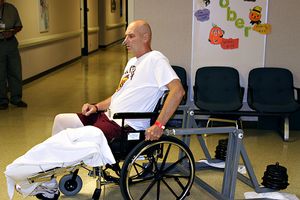
AP Photo/Doug Dreyer
Minus a leg, his spleen and some of his small intestine, Don Meyer faces a long uphill climb.
ABERDEEN, S.D. -- The Toyota Prius slowly drifted across the lane and directly into the path of the oncoming semitrailer truck hauling 90,000 pounds of grain, and Matt Hammer, five cars back, kept waiting for it to jerk back to the right side of the road. Brett Newton, in a car directly behind the veering vehicle, shouted aloud to the driver who could not hear him: "Coach! Coach!"
An explosion, a cloud of metal, and the two driver's-side doors rocketed skyward. The collision of two vehicles moving in opposite directions at more than 50 mph looked like something you see on television, a witness said later.
Hammer pulled off the road and started running toward the Prius, past other cars that had gone into a ditch to avoid the wreckage. He could see that the driver's side was destroyed, crumpled like a soda can. "And on the way there," Hammer remembered later, "I was getting myself ready. I didn't know if I was going to see one of the most influential people in my life dead."
The driver in the wreck on the long, straight South Dakota road on Sept. 5, 2008, was Don Meyer, 64 years old. Husband to Carmen Meyer for 41 years. Father of three, grandfather to eight.
Mentor to hundreds.
The head basketball coach at Northern State University, in Aberdeen, S.D., Meyer ended the 2008 season ranked second in NCAA men's basketball history in career victories, passing Dean Smith and needing just 12 more wins to catch Bob Knight. He was leading a late-afternoon caravan of his players, in six cars, on a 40-mile drive to the Wolves' annual team-building retreat, and he apparently fell asleep at the wheel, as his wife had long feared he would.
By the time Hammer, a former player at Northern State and now a graduate assistant, reached the vehicle, Newton and Kyle Schwan -- two players -- were already there. Meyer was alive, but pinned into the vehicle by the steering column, dazed, the breath coming out of him with a sound "I never want to think about again," Newton said.
"He was out of it," Hammer recalled. "He didn't realize where he was. And then all of a sudden you could see his eyes zone in, and he focused."
Meyer asked softly, "Is everyone OK?"

Courtesy of Northern State University
When Meyer moved into the No. 2 position on the all-time wins list last season, his players led the celebration.
In practice and in the players' classroom work, he'd pounded this into their brains:
Don't compound mistakes. He'd trained them to think rationally in moments of stress, rather than rush or panic. He told them this in the context of basketball, but they long since had come to understand that his words went deeper than that. "NBA," he called it: Next Best Action.
See the need, fill the need, he told them, over and over.
One of them immediately called 911; others dealt with the traffic bottleneck. The driver of the semi, Don Carda, was shaken but OK; nobody other than Meyer was injured. Newton and Schwan tended to the coach through the driver's-side opening, Newton holding the seat belt away from his chest. Hammer climbed into the passenger seat, and they got Meyer to focus on his breathing, on taking steady, measured breaths.
What they couldn't see was that every rib in the left side of his chest was broken. They couldn't see that his diaphragm -- the muscle that lines the rib cage -- was torn away from the bone, or that his spleen was irreparably damaged and his liver was lacerated. His left leg … well, the players couldn't see that, either, in the dark crumpled mass underneath the steering wheel.
Blood trickled down his forehead and down the top of his nose. His left wrist started to swell. They could see that.
"It looked like his wristwatch was going to pop off," Hammer recalled. The players gently wiped shattered glass away from his face.
Newton and Schwan led Meyer in a recital of the Lord's Prayer, and a group of the younger players held hands in a circle next to the truck and said it, too.
Our father, which art in heaven, Hallowed be thy name. Thy kingdom come, thy will be done …
Ten minutes passed; fifteen. The waiting continued. Meyer started talking about how he felt tired. "I've got to go to sleep," he said.
And Schwan started yelling at his coach in the way Meyer had long yelled at him. It was the next best action.
The toughest thing Meyer ever shouted at Schwan in practice was about his father, who coached his son in basketball in high school. "Do I look like your daddy?" Meyer barked at Schwan when he was a freshman. "You're not playing for your daddy anymore!" Another: "This is not Class F basketball in South Dakota, Kyle! This is college basketball!"

Courtesy of Northern State University
Meyer's daily workouts in the hospital were demanding. After all, he devised them himself.
Coach's voice was loud, ricocheting off the walls; and his one-liners could be abrasive, his honesty brutal. It was the way he taught them, the way he taught all his players through the years, stalking the sidelines during games, glaring. He'd worked at one of Knight's camps in one of his first seasons in coaching and admired the way he taught. Anyone seeing Meyer coach for the first time walked away saying he reminded them of Knight. Meyer himself believed the influence of Knight was pivotal to his own career.
Meyer's players jotted his mantras into thick notebooks, and he demanded that they adhere to them. When they made mistakes in practice, they ran and did push-ups as punishment. He challenged them to be disciplined, to be better, to demand more from themselves and from their teammates, to focus. He challenged them to be tougher, keeping a stash of walnuts -- with their almost impenetrable shells -- in his office to hand out when he wanted to make a point.
"If you're hurt, then get off the court and we'll get you the best treatment you can have," he once said to a player who had rolled an ankle. "If you're not, then stop flopping on the floor like a fish and get up and get moving."
Meyer was born in 1944, and as with many men of that time, his approval was often implied rather than voiced. Sometimes his youngest players wondered if any affection at all lived behind the gruffness, because of how bluntly he yelled at them. But now Schwan, trying to find a way to keep Meyer alert, started barking at the coach.
"Narrow focus!" he yelled. "Remember the walnuts -- we're tough nuts!"
Schwan was insistent, and Meyer started to get a little angry, but he remained alert and awake. The first emergency vehicle arrived about a half-hour after the accident. The Jaws of Life were needed to extricate him. As Meyer was lifted from the car, Hammer saw a massive amount of blood around his left foot. Through the torn pant leg, he could see bone sticking out. The lower half of his left leg had been shattered; the main artery severed.
Carmen Meyer's cell phone rang.
"There's been a little accident," she was told, gently, and someone would meet her to take her to the hospital. She had long worried that her husband's voracious work habits and stubbornness would cause him to fall asleep at the wheel someday.
He was flown by helicopter 20 miles to Aberdeen; but emergency-room doctors there quickly realized he needed more extensive medical care than they could provide, and determined he would be flown to Sioux Falls, 200 miles away. Doctors encouraged Carmen Meyer to spend some time with him before he left, and she sensed their fear that he would not survive the night.

AP Photo/Doug Dreyer
Even in his hospital room in Sioux Falls, he was never without his phone and his planner.
At 3 a.m. in Sioux Falls, a trauma surgeon emerged from the operating room to explain the work he had done on her husband: removal of his spleen and part of his small intestine, reattachment of his diaphragm, the condition of his leg and their concern for it.
And then the surgeon said, "And by the way -- do you know that your husband has cancer?"
Carmen Meyer thought: Why don't you go ahead and hit me with a two-by-four?
The doctors, more immediately concerned about his leg, asked Carmen to wait to tell her husband about the cancer. A week later, after three more operations on his leg, she and their daughter Brooke and others explained to Meyer that doctors had discovered lesions on his liver and small intestine.
He wept, but he assured them: "I'm not scared. It's just emotional, and hard to hear."
Meyer had heard the talk about the damage in his left leg. He let his droll wit handle that one.
"Doc," he said. "Just cut it off."
Two weeks after the accident, doctors amputated the bottom part of his left leg, about eight inches below the knee.
Within days, Meyer was referring to his right, healthy leg as Big Buddy, and his left leg as Little Buddy.
Philip Hutcheson's phone rang in Nashville, and Wade Tomlinson heard in Indiana. Word spread quickly among his former players and colleagues, from his years at Hamline University in St. Paul, at Lipscomb University in Nashville, from the years he spent running summer basketball camps and the Don Meyer Coaching Academy. Bob Starkey, associate head coach at Louisiana State, sent a mass e-mail out to other coaches mentioning that Meyer had a particular liking for pens, and he encouraged others to send them along to Meyer. Hundreds arrived, in every color, in every style, his assistant coaches collecting them in a square cardboard box. John Wooden reached out to him; Knight wrote a note. Hutcheson and Tomlinson -- who played for Meyer and contended for NAIA championships at Lipscomb -- visited him in the hospital.
They found their stoic old coach, lying in the hospital and recovering from a fight for his life, to be much more expressive than they had ever known him to be.
"He was still same old coach, telling me what I needed to do," Hammer recalled. "He was looking out for the team. But when I was there, Philip and Wade were there, and he told them how much he loved them and how much he appreciates them. In the trenches, in the heat of battle, he'd say some things that weren't very nice. So when you heard words like that -- 'I love you' -- it was nice to hear that."
Doug Dodge, another of Meyer's former players, came to visit and told Carmen Meyer, "That was the best four hours in my life with Coach."
When he was in intensive care, Meyer spoke with Schwan alone and told him he loved him.
"Kyle, I've got many sons," he said. "If I had to write a book, that's what it would be called: 'I've Got Many Sons.'"

AP Photo/Doug Dreyer
Under Meyer, practice is never laid-back. He directed this steely gaze at a workout late last February.
He remained hospitalized for almost two months, during which time he had eight surgeries, the last a skin graft to help cover the end of his stump. Bits of windshield glass once embedded in his skin regularly worked their way out and appeared on the sheets at the hospital. But it didn't keep him from a daily physical rehabilitation routine -- his own workouts -- to rebuild his strength.
A strip of yellow paper was placed on the wall opposite his bed, and Meyer covered it with the same words he'd written on grease boards for his players through the years.
YOU GOTTA KEEP DANCIN'.
STAY AHEAD OF THE PAIN.
DO THE NEXT RIGHT THING RIGHT.
"How many guys are going to get through a wreck like that alive, and then to have cancer like I have and have them find it because of that? That has to be some kind of blessing," he said.
On Oct. 30, Meyer sat in his wheelchair in a hospital hallway and signed the paperwork for his release. Some of the nurses wore Northern State T-shirts. When someone asked him if he could push himself along in his wheelchair, he smiled and tucked the pen inside his shirt collar.
"It'll be slow," he said, "but I'll get there."
Using a crutch, Meyer carefully lifted himself out of the wheelchair and slid into the front seat of the car that Carmen had driven from Aberdeen; she hadn't been home since the accident. Another patient asked, "Coach, are you happy?"
"I'm thinking about it," he said, smiling slightly.
The next morning, at 4:45 a.m., Don Meyer was in his office, working.
There wasn't ever a time, assistant coach Randy Baruth said, when Meyer suggested he wouldn't coach again. The day after the accident, Meyer spoke to Baruth alone in intensive care and told him, "You're going to have a lot on your plate for a little while."
The implication was clear. Meyer would be back.
Basketball, central to his life, has been a blessing and a curse to him in recent weeks. As he went through his rehabilitation, the forthcoming season provided a natural goal for him. He desperately wanted to be at the Wolves' exhibitions at the University of Minnesota and Purdue in early November.
"My players need me," he told others in the hospital.

Courtesy of Northern State University
"It'll be slow," Meyer said about his ability to move around, "but I'll get there."
But his own lifelong standard for how hard he should work is at odds with the needs of his traumatized body's recovery. Just a week after being released from the hospital, he insisted on making the team's three-day bus trip to Minneapolis and West Lafayette. At the first stop, a bass drum belonging to a member of the Minnesota band accidentally fell against Meyer's stump. He approached his wife, his face ashen, and told her he needed his pain medication immediately.
Meyer has lost about 20 pounds since the accident, but Carmen noticed that his slacks weren't loose -- his left side remains swollen, misshapen.
At his first practice back, he couldn't shout; his lungs, still badly bruised, couldn't generate the necessary force. He sat in his wheelchair on the sidelines, taking notes. Baruth assigned a manager to patrol the area near Meyer, so no bouncing ball would hit Little Buddy.
After the road trip, early last week, he had a difficult, emotional day. He lasted only 15 minutes at practice before leaving the rest of the work to Baruth, who has encouraged him to rest as much as possible, as much as his body requires, precisely because he is needed.
"Randy has Don's best interests at heart," Carmen Meyer said. "He's gradually going to make that transition."
And week to week, they all see their coach improving, his voice strengthening. Last Saturday, he even erupted at a player when a ball hit the rim and eluded one of his forwards.
"I could've grabbed that rebound from this wheelchair!" he shouted, and Hammer and Schwan and Newton smiled inwardly.
"It's nice to have Coach back," Schwan said. "His eyes, what he sees. You can tell his energy is getting back and he's getting more vocal. He doesn't have the daily energy that he had yet, but we understand that, for what he's been through."
Meyer remembers little about the accident. A flash of white when the air bag deployed. The way his players cajoled him as they waited for help to arrive. He doesn't like to talk about the extent of his injuries, or the cancer. Recently, the Meyers met with an oncologist, who explained the details of the treatment -- the process has just started -- and his possible prognosis; and afterward, Meyer told Carmen that going forward, he didn't want to know any of that. He just wanted to be told this: What's the best thing he could do next?
His players feel the same way.
"This still isn't over," Schwan said. "This is still a process that we still have to go through. This first game is going to be emotional, and we've got to handle that right. Coach could have infection issues; he could have blood-clot issues. The thing isn't over. We still have to do our job every single day. We can't take a day for granted."
On Sunday, practice ended at 6 p.m. A few minutes later, Hammer pushed Meyer, in his wheelchair, out of the Barnett Center and into a cold South Dakota November night. A walker was placed in front of his wheelchair and Meyer stood, leaning on the chair, his right hand in a brace. A doctor told him he might have a stress fracture from the strain he has put on his wrists since he lost his leg.
But he moved the six feet to a waiting car, turned slightly and lowered himself into the passenger's side for the ride home. Hammer folded the walker and the wheelchair and set them in the back.

Courtesy of Northern State University
When Meyer speaks, people listen. He has influenced countless students over the years, including at this assembly before the accident.
On the drive home, his car approached an intersection, and Meyer acknowledged that he feels nervous now when a semitrailer comes at him from the other direction.
After the car pulled into his driveway, Meyer used the walker to get through the door of his garage and stepped onto a hydraulic handicap lift that was built in his home. He worked out for an hour -- leg lifts on a table in the living room -- talking about his team, fretting that the Wolves must start playing better.
There is work to be done, with his team, with his body.
Later Sunday night, he lay in his bed and directed his eyes at the ceiling, and rested the stump of his left leg on a towel -- a dark towel, which Carmen uses because of the blood. His wife pulled off the sleeve covering his left leg. The triangular-shaped wound, with the flap of calf muscle and skin pulled over the front, hasn't healed, and may not heal for months. Meyer can't be fitted for a prosthetic leg until the wound heals and the swelling goes down.
Carmen makes note of a small white spot inside the triangle for a visitor.
"There's the bone," she said.
She sprayed the wound with antiseptic and used a Q-tip to clean a fold of skin.
"There's no blood here," she reported to her husband, a good sign.
But Meyer didn't want to look. He pinched the bridge of his nose with his fingers and squinted. He had basketball practice in eight hours, and on Tuesday night the first game of the regular season, against Mount Marty College.
He is healing, day by day, and there is work to be done.
It's the next best action.
Buster Olney is a senior writer for ESPN The Magazine. Don Meyer is the subject of an upcoming "E:60" feature. ESPN will follow him as he continues to recover and makes his way toward college basketball history.
Original here





 has signed a five year contract extention, worth 6.6 million per year, totalling 33 Million Dollars. The deal makes him the highest paid player on the Avs, and if nobody gets more, he will be until 2013-2014. Clearly, Paul has shown that he is the successor to Joe Sakic, and has been paid accordingly.
has signed a five year contract extention, worth 6.6 million per year, totalling 33 Million Dollars. The deal makes him the highest paid player on the Avs, and if nobody gets more, he will be until 2013-2014. Clearly, Paul has shown that he is the successor to Joe Sakic, and has been paid accordingly. The Massillon Tigers will be making use of a facility that is 20,000 square feet larger than that of the Cleveland Brown. The Cincinnati Bengals do not yet have their own indoor practice arena.
The Massillon Tigers will be making use of a facility that is 20,000 square feet larger than that of the Cleveland Brown. The Cincinnati Bengals do not yet have their own indoor practice arena.








